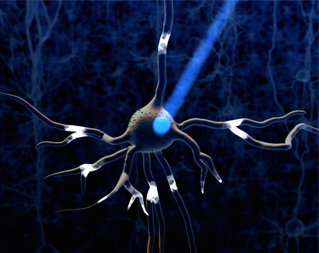
Light-driven controls could illuminate the circuitry of the brain
In optogenetics, light triggers genetically modified cells. In this case, a blue light shining on a brain cell turns it on. (Image courtesy of Edward Borden.)
“Brain control” brings to mind an image of evil scientists hidden away in a dark lab preparing an army of zombies to do their bidding. In reality, Edward Boyden, associate professor of biological engineering and brain and cognitive sciences and head of the Synthetic Neurobiology Group at the Massachusetts Institute of Technology, hopes that controlling a mouse brain can reveal its biological circuitry.
Boyden and his team develop “optogenetic” tools, which use light to control neurons, or brain cells. He described their work Oct. 11 at CASW’s New Horizons in Science briefing for science writers, held at MIT as part of ScienceWriters2015.
The lab’s optogenetic tools are derived from genes in green algae. The genes code for protein molecules, which form light-sensitive pores on the cell surface. In the presence of light, the pores open, allowing electrically charged particles to pass into or out of the cell. The algae use the flow of charged particles to fuel the biochemical engine that propels the cell toward the light source. When the algal genes are incorporated into neurons in the mouse brain, the light-sensitive pores have a different function: they control the activation of the cells, launching signals into the nerve network of the brain.
In one set of experiments Boyden and his colleagues implanted the genes into neurons responsible for dopamine release in the mouse brain, thus allowing light-triggered dopamine release. Boyden was able to verify that the genes were correctly incorporated into the mice by watching for reward-seeking behavior. The mice repeatedly pressed a button to produce a flash of light, which provided a reward by stimulating the modified neurons.
Dopamine deficiencies are linked with Parkinson’s disease, schizophrenia and attention deficit hyperactivity disorder (ADHD). By creating mechanisms to control the release of dopamine, scientists may someday map the cause of dopamine deficiencies as well as implement gene therapies for these disorders.
A toolkit for understanding the mind?
The first optogenetic tools were developed in the early 2000s by Boris Zemelman and Gero Miesenböck of the Sloan-Kettering Cancer Center, but Boyden and his colleagues have begun expanding them into a larger toolkit. This library includes tools that act on various families of neurons and respond to different wavelengths of light. For example, Boyden’s group has developed optogenetic tools sensitive to infrared light, which can penetrate flesh and bone.
How does this work help scientists learn about the complicated circuitry of the brain? Other techniques allow the investigator to passively observe neural activity, but taking control of the cell offers the opportunity to turn on the switch and create a response, thereby getting a glimpse of cause and effect.
As Boyden said in an interview following his New Horizons talk, “If we can really understand the human mind with some kind of mechanistic precision, that might be very useful for understanding things like strife and irrationality and all sorts of other human frailties and issues.”
Boyden, dubbed “King of the Nerds” this year by the MIT biological engineering department, began his academic career by studying electrical engineering at MIT. He explained his change of direction: “I realized I was primarily driven by philosophical questions: Why are we here? What is the meaning of thought? What is the meaning of life? I decided to switch to neuroscience.”